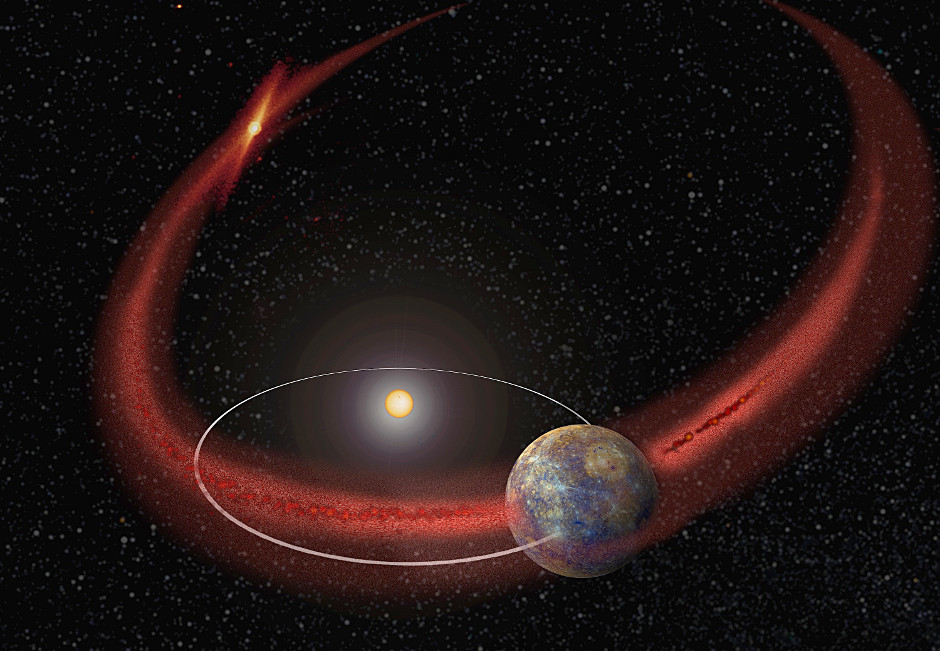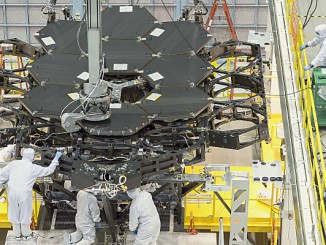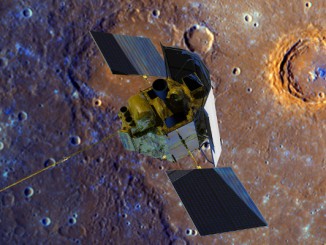
The findings are to be presented at the 47th Annual Meeting of the Division for Planetary Sciences of the American Astronomical Society at National Harbor, Maryland, this week, by Apostolos Christou at the Armagh Observatory in Northern Ireland, Rosemary Killen at NASA’s Goddard Space Flight Center in Greenbelt, Maryland, and Matthew Burger of Morgan State University in Baltimore, working at Goddard.
At certain times of the year, our planet passes through streams of dust left behind by comets, leading to a natural fireworks display: a meteor shower. One of the best-known, the August Perseids, originates from Comet Swift-Tuttle, last seen back in 1992 and not to return in the inner solar system for another century. But the Earth is not the only planet to sweep up cometary dust in this fashion. Last year, a comet called Siding Spring grazed the planet Mars, loading its upper atmosphere with tons of cometary material. The aftermath was recorded by instruments onboard Mars-orbiting probes like NASA’s MAVEN and ESA’s Mars Express.
For airless bodies like the Moon and Mercury, we have known since the Apollo landings that they are surrounded by clouds of atomic particles either launched from the surface or brought in by the solar wind. Though tenuous compared to the dense atmospheres of the Earth or Mars, these “surface boundary exospheres” are now recognised to be complex and dynamic entities, fascinating to study in their own right.
NASA’s MErcury Surface Space ENvironment, GEochemistry, and Ranging (MESSENGER), the first spacecraft to orbit Mercury, measured how certain species in the exosphere vary with time. Analysing the data, Burger and colleagues found a pattern for the element calcium that repeats from one of Mercury’s 88-day long years to the next. To investigate, Killen worked with Joe Hahn of the Space Science Institute, based in Austin, Texas, to understand what happens when Mercury ploughs through the so-called zodiacal cloud of interplanetary dust around the Sun and its surface is pelted by high-speed meteoroids.
The researchers found that both the amount and the pattern of calcium could be explained in terms of the material thrown off the planet’s surface by the impacts. But one feature in the data did not make sense: the peak in calcium emission is seen right after Mercury passes through its perihelion — the closest point of its orbit to the Sun — whereas Killen and Hahn’s model predicted the peak to occur just before perihelion. Something was still missing.
That “something” arrived in the form of a comet. Named after the German mathematician who computed its orbit, Comet Encke has the shortest period of any comet, returning to perihelion every 3.3 years at a distance of 30 million miles (48 million kilometres) from the Sun. Its orbit is stable enough so, over millennia, a dense dust stream would have formed. In their paper, Killen and Hahn proposed that Encke dust impacting Mercury could kick up more calcium from the surface and explain the MESSENGER data. The match was not perfect, however. Encke encounters Mercury’s orbit about a week later than the calcium peak. The researchers postulated that the stream’s evolution over thousands of years had somehow shifted it away from the comet’s present orbit.
But what was causing the shift? To find out, Killen and Burger teamed up with Christou to simulate the evolution of the Encke stream for several tens of thousands of years — the likely lifetime of the comet. Christou followed a cloud of simulated dust grains launched from the comet’s nucleus to find out if — and, more importantly, where — their present orbits would intersect Mercury’s. He found that the dust, rather than shift away from the comet’s orbit, simply spreads along it, forming a stream that encounters Mercury exactly when the comet does.
Then he reran the model, to allow for a subtle interaction between the dust grains and sunlight called Poynting-Robertson drag. This exerts an extra, though tiny, force on the grains which, over long periods of time, could amount to a significant change in the orbit. The result was that the orbit of the stream in the simulations shifted behind the comet’s orbit and toward the location of the observed calcium peak. Moreover, the size of the shift depended on the size of the dust grains — bigger grains means a smaller drag force — and on how long ago they were released from the comet. Christou found that he could reproduce the timing of the calcium peak for grains a millimetre or so in size, ejected from Encke between 10,000 and 20,000 years ago. This is consistent with what we know about cometary dust, as droves of millimetre-sized cometary grains enter the Earth’s atmosphere every day, creating visible meteors. It also agrees with the age estimate of the stream based on Earth-based meteor studies.
“Finding that we can move the location of stream to match MESSENGER’s observations is gratifying, but the fact that the shift agrees with what we know about Encke and its stream from independent sources makes us confident that the cause-and-effect relationship is real,” Christou explained.
The work has set an interesting precedent on the importance of the different dust populations in exosphere production.
“We already knew that impacts were important in producing exospheres,” Killen said. “What we did not know was the relative importance of comet streams over zodiacal dust. Apparently, comet streams can have a huge, but periodic, effect.”
Killen looks forward to searching for the signature of the Encke stream on other exospheric species. “This will be further confirmation of the relationship,” she added.



